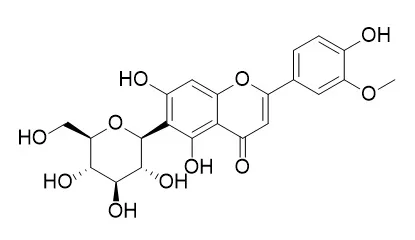| In vitro: |
| Food Chem. 2018 Feb 15;241:154-162. | | Identification and quantification of flavonoids in yellow grain mutant of rice (Oryza sativa L.).[Pubmed: 28958514] | Flavonoids are naturally occurring phenolic compounds with potential health-promoting activities. Although anthocyanins and phenolic acids in coloured rice have been investigated, few studies have focused on flavonoids.
METHODS AND RESULTS:
Herein, we analysed flavonoids in a yellow grain rice mutant using UHPLC-DAD-ESI-Q-TOF-MS, and identified 19 flavonoids by comparing retention times and accurate mass measurements. Among them, six flavonoids, isoorientin, isoorientin 2″-O-glucoside, vitexin 2″-O-glucoside, isovitexin, Isoscoparin 2″-O-glucoside and Isoscoparin, were isolated and fully identified from the yellow grain rice mutant, and the levels were significantly higher than wild-type, with isoorientin particularly abundant in mutant embryo. Significant differences in total phenolic compounds and antioxidant activity were observed in mutant rice by DPPH, FRAP and TEAC assays.
CONCLUSIONS:
The results suggest that the representative six flavonoids may play an important role in colouration and antioxidant activity of embryo and endosperm tissue. The findings provide insight into flavonoid biosynthesis and the possibility of improving functionality in rice. | | Phytother Res. 2014 Jul;28(7):1064-70. | | A new phenolic component from Triticum aestivum sprouts and its effects on LPS-stimulated production of nitric oxide and TNF-α in RAW 264.7 cells.[Pubmed: 25165783] | An unusual new phenolic component, triticumoside (1), and eight known compounds, isoorientin (2), Isoscoparin (3), (2R)-2-O-β-D-glucopyranosyloxy-4,7-dimethoxy-2H-1,4-benzoxazin-3(4H)-one (4), adenosine (5), β-sitosterol (6), daucosterol (7), 6′-O-linolenoyl daucosterol (8), α-tocopherol (9), were isolated fromTriticum aestivum sprouts.
METHODS AND RESULTS:
The hybrid structure of 1, which is a hybrid between a flavone and a polyoxygenated benzene, is rarely found in natural sources. In addition, the effects of these compounds on LPS-induced NO and TNF-α production in RAW 264.7 cells were evaluated. At a concentration of 2.0 μM, compounds 2-4 significantly inhibited the production of both NO and TNF-α. Compound 1 exhibited inhibitory activity on the secretion of TNF-α at concentrations as low as 2.0 μM, but it did not reduce NO levels at any of the tested concentrations. |
|






 Cell. 2018 Jan 11;172(1-2):249-261.e12. doi: 10.1016/j.cell.2017.12.019.IF=36.216(2019)
Cell. 2018 Jan 11;172(1-2):249-261.e12. doi: 10.1016/j.cell.2017.12.019.IF=36.216(2019) Cell Metab. 2020 Mar 3;31(3):534-548.e5. doi: 10.1016/j.cmet.2020.01.002.IF=22.415(2019)
Cell Metab. 2020 Mar 3;31(3):534-548.e5. doi: 10.1016/j.cmet.2020.01.002.IF=22.415(2019) Mol Cell. 2017 Nov 16;68(4):673-685.e6. doi: 10.1016/j.molcel.2017.10.022.IF=14.548(2019)
Mol Cell. 2017 Nov 16;68(4):673-685.e6. doi: 10.1016/j.molcel.2017.10.022.IF=14.548(2019)